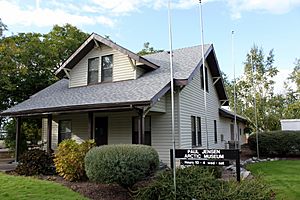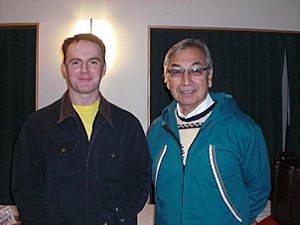Jensen Arctic Museum facts for kids
 |
|
| Established | 1985 |
|---|---|
| Location | Monmouth, Oregon, United States |
| Type | Arctic |
| Visitors | 4,000 (2006–07) |
The Paul H. Jensen Arctic Museum was a special museum that taught people about the Arctic region. It was located in Monmouth, Oregon, on the campus of Western Oregon University (WOU). The museum first opened its doors in 1985. It displayed over 3,000 artifacts collected by its founder, Paul Jensen. The museum grew to hold 5,000 artifacts. It featured exhibits on Arctic wildlife and the cultures of the Inuit and Eskimo peoples from Alaska. This museum was one of only two museums in the lower 48 U.S. states focused on Arctic life. It was also the only one on the West Coast. In 2013, WOU announced that the Jensen Museum would close. Its collections moved to the University of Oregon Museum of Natural and Cultural History (MNCH) in Eugene. The MNCH also has many Arctic items.
Contents
Museum History and Growth
The Jensen Arctic Museum was started in June 1985 by Paul Jensen. He used artifacts he had collected from Alaska. He gathered these items over 25 years while working as a researcher and teacher. Most of the collection came from gifts given by native Alaskans. Jensen was a retired professor from Western Oregon University. He served as the museum's curator and director until he passed away in 1994. By 1993, the museum's collection had grown to 3,000 artifacts. About 7,000 visitors came to the museum each year.
Special Events and Funding
In 1995, the museum celebrated its ten-year anniversary. They held a party that included traditional Eskimo dancers. In 1997, the museum received a $5,000 federal grant. This money helped them to better preserve their valuable artifacts.
In January 2005, the museum hosted a special event called the Whale in Science and Culture Symposium. Speakers from the Oregon Coast Aquarium and Oregon State University shared their knowledge. Each year, the museum also held a traditional salmon bake. This event was a fundraiser. They cooked 300 pounds of salmon every year. The 28th annual salmon bake took place in 2013. It was at this event that the museum announced its collection would move. The artifacts went to the MNCH at the University of Oregon. This museum is the official place for anthropological collections owned by the state of Oregon. Jon Erlandson, the director of the MNCH, explained that Arctic cultures and environments are changing quickly. He said the Jensen Arctic Collection holds priceless records of these changes. These records will be used for research and public education.
Amazing Arctic Collections

The museum focused on the culture of the Inuit and Eskimo peoples from Alaska. It held over 5,000 artifacts. These items were displayed in a former home on the campus of Western Oregon University in Monmouth. The artifacts included items that showed the natural environment of these native Alaskans. To highlight the environment, the museum had a room just for Arctic wildlife. This room was a life-sized diorama called the Circumpolar Room. It had an automated system that told stories about Arctic animals. Lights would shine on busts (head and shoulder sculptures) of these animals. Animals on display included musk ox, wolves, Arctic fox, a polar bear, brown bears, a snowy owl, and caribou.
Unique Artifacts and Daily Life Displays
One very special item in the Jensen collection was a 27-foot-long umiak. This is an Inuit boat. Its frame was made from driftwood and covered with walrus skins. People from St. Lawrence Island in the Bering Sea gave this boat to Paul Jensen. He even used it to travel around the island during a native hunt. Other large items included a traditional Inuit home. It was built from stones, animal hides, whalebone, and driftwood. There was also an 11-foot-long sled and a sod house.
The museum also had displays showing the daily lives of the Inuit and Eskimos. These mainly focused on the Inupiaq and Yupik Eskimos. Exhibits showed their clothing and artwork. Artifacts included ivory carvings, parkas, and jackets made from seal, wolf, and bear skins. There was also a yo-yo-type children's toy and an anchor made from a whalebone. Other items in the collection included ropes, ivory from mammoth and mastodon tusks, and animal bones. There were also ceremonial masks carved from wood or bone, wooden dolls, mukluks, and combs carved from ivory. Knives and harpoon heads were also on display. The museum also had a dog sled, a kayak, snowshoes, baskets, and toys. The artwork included drawings on sealskins using ink. Some of these pieces dated back to the 1930s.
About Paul Henry Jensen
The museum was named after its founder, Paul Henry Jensen. He was an immigrant from Denmark. As a child in Denmark, he had several classmates who were Inuit. Jensen was born on August 17, 1907, in Teestrup, Denmark. He moved to Canada in 1925 but returned to Denmark in 1927. He served seven months in the army, as was required by law. Then, he moved to the United States in 1928. Jensen arrived at Ellis Island in 1928. He then moved to Montana before starting college. He first attended Spokane College in Washington State. In 1935, he earned his bachelor's degree from Midland College in Nebraska. He then received a doctorate in 1938 from the University of North Dakota. He married Arlene Munkres, and they had two sons and three daughters.
Jensen's Work with Native Alaskans
After some more studies at the University of Washington and Oregon State University, Jensen began working in the Arctic. Starting in 1962, he worked to improve the cultural resources for the Eskimo people. He helped over 3,000 people come to Oregon. He also set up seven libraries in Alaskan villages. In total, he spent over 30 years teaching Eskimo children in Alaska. In 1966, he was hired at Western Oregon State College (now Western Oregon University) as a researcher. In 1968, he became a professor at the school. Jensen retired from teaching in 1979. For his work with native Alaskans, he was made an honorary member of the Alaska Council of Elders in 1984. The Eskimos knew him as Angyalik, which means "captain of the ship." The next year, he founded the museum with his artifacts. He served as its curator and director until he passed away on September 26, 1994.

